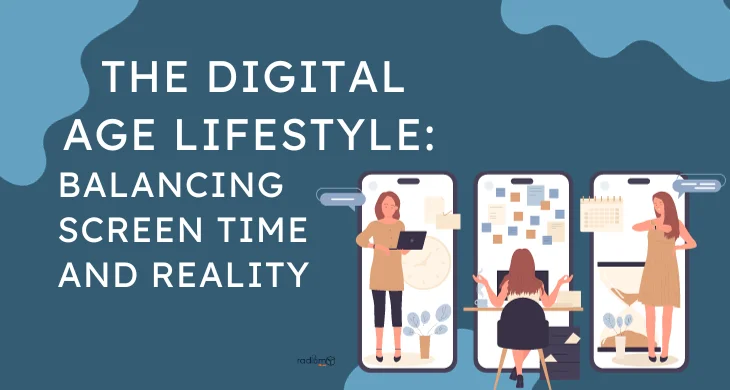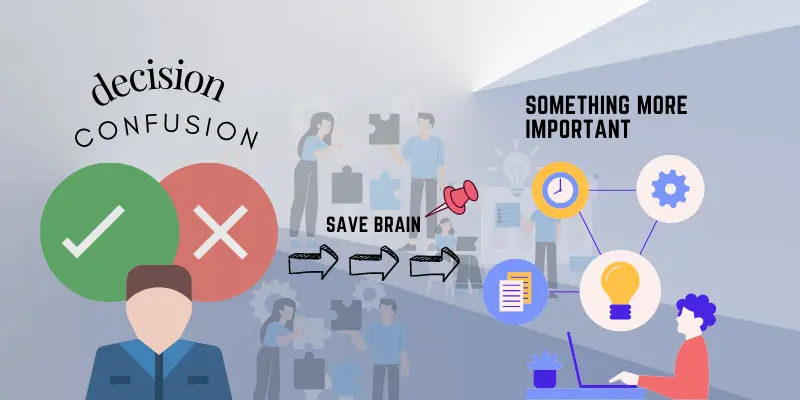In today’s digital age, technology and screens are an integral part of our daily lives. From smartphones and tablets to laptops and smart TVs, we are constantly connected to the digital world. While technology offers convenience, entertainment, and productivity, it also raises concerns about the impact of excessive screen time on our physical and mental well-being.
This blog will delve into the intricacies of balancing screen time with real-life experiences. We will explore the effects of prolonged screen exposure, the importance of setting boundaries, and practical tips to maintain a healthier and more fulfilling digital-age lifestyle.
The Digital Age Dilemma:
In the midst of the digital age, screens have become an integral part of our daily existence. Whether it’s the smartphone in your pocket, the laptop on your desk, or the smart TV in your living room, screens surround us. They offer convenience, entertainment, and connection to a world beyond our physical reach. However, this digital transformation has brought with it a dilemma that requires our attention and mindfulness.
The Prevalence of Screens:
Screens are virtually omnipresent. They accompany us during work, leisure, and even moments of relaxation. We use them to communicate, learn, work, and unwind. In many ways, screens have enriched our lives, making tasks more efficient and information more accessible than ever before.
The Downside of Excess:
Yet, the more we embrace screens, the more we encounter the downsides of excessive screen time. The digital age dilemma encompasses a range of challenges:
- Physical Health Impact: Prolonged screen use can lead to physical health issues. Poor posture, eye strain, and disrupted sleep patterns are common complaints.
- Mental Well-Being: The constant bombardment of information and digital stimuli can take a toll on our mental health. Stress, anxiety, and even digital addiction are on the rise.
- Social Disconnect: Paradoxically, while screens connect us virtually, they can also lead to disconnection in our real-life relationships. Face-to-face interactions may diminish as digital interactions increase.
Effects of Extended Screen Time on Physical Health:
In the digital age, our reliance on screens has surged dramatically, with smartphones, tablets, computers, and televisions becoming constant companions in our lives. While these screens offer immense benefits, such as communication, information access, and entertainment, the prolonged and often excessive use of screens can significantly impact our physical health.
Understanding the Physical Toll:
- Digital Eye Strain: Staring at screens for extended periods can lead to digital eye strain or computer vision syndrome. Symptoms include dry eyes, blurred vision, headaches, and eye fatigue.
- Poor Posture: Engaging with screens often involves hunching over devices, leading to poor posture. This can result in neck, shoulder, and back pain, commonly referred to as “tech neck.”
- Sleep Disruption: The blue light emitted by screens, especially before bedtime, can interfere with our sleep patterns. Poor sleep quality and insomnia are associated with excessive screen time.
- Sedentary Lifestyle: Extended screen use can lead to a sedentary lifestyle, reducing physical activity levels. This lack of movement contributes to various health issues, including obesity and cardiovascular problems.
Combatting the Physical Impact:
- Follow the 20-20-20 Rule: To reduce digital eye strain, take a break every 20 minutes by looking at an object 20 feet away for at least 20 seconds. This helps relax eye muscles.
- Ergonomic Considerations: Set up your workspace and seating ergonomically to maintain good posture. Adjust the height and angle of your screens to minimize strain.
- Blue Light Filters: Use blue light filters on your devices, or wear blue light-blocking glasses to reduce exposure to sleep-disrupting blue light.
- Regular Exercise: Incorporate physical activity into your routine to counteract the sedentary nature of screen time. Stretch, walk, or engage in regular exercise to keep your body active.
- Proper Sleep Hygiene: Establish a screen-free bedtime routine to improve sleep quality. Avoid screens at least an hour before bedtime to allow your body to prepare for rest.
The Mental Well-Being Connection:
In today’s digital age, screens are not just tools; they’re windows to a vast virtual world. While screens offer us a plethora of information, entertainment, and connection, there’s a growing concern about their impact on our mental well-being. The more time we spend glued to screens, the more complex the relationship between our digital lives and mental health becomes.
The Digital Mind Maze:
- Stress and Anxiety: Constant connectivity and information overload can contribute to heightened stress and anxiety levels. The need to respond to messages, emails, and notifications can lead to a constant state of vigilance.
- Digital Addiction: The allure of screens, social media, and online entertainment can lead to digital addiction. This addiction can result in neglect of real-life responsibilities, relationships, and self-care.
- Social Isolation: Paradoxically, while screens connect us digitally, they can lead to social isolation in the real world. Spending too much time online can detract from face-to-face interactions with friends and family.
Strategies for Digital Well-Being:
- Digital Detox: Periodically disconnecting from screens through digital detoxes can help reset your mind. Use this time for introspection, outdoor activities, and reconnecting with the tangible world.
- Mindful Screen Use: Practice mindful screen use by setting boundaries and managing notifications. Allocate specific times for checking emails and social media to prevent constant distractions.
- Stress Reduction Techniques: Incorporate stress reduction techniques like meditation, deep breathing, or yoga into your routine to counteract the mental strain of screens.
- Professional Support: If you find yourself struggling with digital addiction or mental health issues exacerbated by screen time, consider seeking professional help and support.
Nurturing Real-Life Connections in the Digital Age:
In an era dominated by screens and digital interactions, the importance of nurturing real-life connections cannot be overstated. While technology has brought us closer in some ways, it has also presented challenges to our ability to connect on a deeper, more meaningful level in the physical world. However, the power to bridge this gap and foster genuine relationships outside the digital realm lies within our grasp.
The Digital Paradox:
- Virtual Overload: The prevalence of screens has led to an overreliance on virtual communication. Text messages, emails, and social media have become primary means of interaction, often at the expense of face-to-face connections.
- Quality vs. Quantity: While we may have many online connections, the depth and quality of these relationships can pale in comparison to those formed in the real world. Real-life interactions provide nuances, emotions, and shared experiences that virtual conversations cannot replicate.
Strategies for Nurturing Real-Life Connections:
- Prioritize Face-to-Face Time: Dedicate time for in-person interactions with friends, family, and colleagues. These moments allow for genuine conversations and the building of stronger bonds.
- Create Digital-Free Zones: Designate specific spaces or times as digital-free zones, such as during meals or gatherings. This encourages meaningful conversations without the distraction of screens.
- Engage in Shared Activities: Participate in activities that require physical presence, such as hobbies, sports, or volunteering. Shared experiences forge deeper connections.
- Active Listening: Practice active listening during conversations. Give your full attention to the person speaking, and ask open-ended questions to foster meaningful dialogue.
- Digital Etiquette: When spending time with others, practice digital etiquette by minimizing phone use and distractions.
Digital Detox and Mindful Consumption:
In the digital age, where screens beckon from every corner of our lives, the concept of a “digital detox” has gained prominence. A digital detox is a deliberate, temporary disconnection from screens and the online world, allowing us to reclaim control over our digital consumption. Additionally, practicing mindful consumption of digital content has become crucial for maintaining a healthy and balanced relationship with technology.
The Need for a Digital Detox:
- Overwhelm: The constant flow of information, notifications, and digital stimuli can lead to sensory overload and mental fatigue.
- Digital Addiction: Excessive screen time, especially on social media, can contribute to digital addiction, where the need for online validation takes precedence over real-life activities.
- Sleep Disruption: Screens emit blue light, which can interfere with our sleep patterns. Sleep quality suffers when we engage with screens before bedtime.
Embracing a Digital Detox:
- Set Boundaries: Define clear boundaries for screen use. Designate specific times and spaces for screen-free activities.
- Unplug Regularly: Plan regular digital detoxes. These can range from a few hours of screen-free time to full weekends of disconnection.
- Engage in Offline Activities: Use digital detox time to engage in offline hobbies, connect with nature, read physical books, or spend quality time with loved ones.
- Prioritize Sleep: Create a screen-free bedtime routine to improve sleep quality. Avoid screens at least an hour before sleep.
Practicing Mindful Consumption:
- Audit Your Digital Diet: Regularly assess the content you consume. Unfollow accounts or unsubscribe from sources that do not add value to your life.
- Question Motivations: Before reaching for your device, ask yourself why. Are you seeking information, connection, or distraction? Understanding your motivations helps you make mindful choices.
- Avoid Multitasking: Concentrate on a Single Task at a Time.Multitasking can lead to shallow consumption and decreased attention span.
- Practice Information Curiosity: Approach digital content with curiosity and discernment.
The Benefits of Digital Detox and Mindful Consumption:
- Improved Mental Health: Reduced screen time and mindful consumption can alleviate stress and anxiety.
- Enhanced Focus: Mindful consumption promotes deeper focus and concentration.
- Restorative Sleep: A digital detox can lead to improved sleep quality and overall well-being.
- Reconnection: Disconnecting from screens fosters reconnection with real-life experiences and relationships.
Setting Screen Time Boundaries:
In an era where screens have become ubiquitous, setting boundaries on screen time has become essential for maintaining a healthy and balanced lifestyle. Without these boundaries, it’s easy to fall into the trap of excessive screen use, which can impact our well-being, productivity, and relationships. This guide explores the importance of setting screen time boundaries and offers practical strategies to regain control over your digital life.
Understanding the Screen Time Challenge:
- Digital Overload: The digital age bombards us with a constant stream of information, notifications, and entertainment, making it challenging to disconnect.
- Quality vs. Quantity: Spending hours in front of screens doesn’t necessarily translate to productive or meaningful use of time. It’s the quality of our screen time that matters most.
Strategies for Setting Screen Time Boundaries:
- Define Your Priorities: Identify your priorities and allocate screen time accordingly. This includes work, personal communication, leisure, and relaxation.
- Set Specific Limits: Establish daily or weekly limits on screen time for different activities. For example, limit social media use to 30 minutes a day.
- Create Screen-Free Zones: Designate certain areas in your home, such as the dining room or bedroom, as screen-free zones to encourage face-to-face interactions and better sleep.
- Use Apps and Tools: Utilize screen time management apps and features on your devices to track usage and set reminders for breaks.
- Schedule Screen-Free Time: Incorporate screen-free time into your daily routine. Use this time for physical activity, reading, or other non-screen activities.
The Benefits of Setting Screen Time Boundaries:
- Improved Productivity: Setting boundaries can help you stay focused and productive, especially during work or study sessions.
- Enhanced Well-Being: Reduced screen time can lead to improved mental and physical well-being, including reduced stress and eye strain.
- Better Relationships: Setting screen time limits allows for more meaningful and undistracted interactions with loved ones.
- Quality Leisure: By setting boundaries, you can ensure that your leisure time is spent on activities you genuinely enjoy and that contribute to your personal growth.
Faqs:
Q1: Why is it important to balance screen time and reality in the digital age?
A1: Balancing screen time and reality is vital for physical and mental well-being. Excessive screen exposure can lead to health issues like eye strain and disrupted sleep, as well as negatively impact our social connections and mental health.
Q2: How can I reduce digital eye strain caused by excessive screen time?
A2: To reduce digital eye strain, follow the 20-20-20 rule: every 20 minutes, look at something 20 feet away for at least 20 seconds. Adjust screen brightness and ensure proper lighting to minimize glare.
Q3: What are some signs of digital addiction, and how can I address them?
A3: Signs of digital addiction include compulsive screen use and neglect of real-life responsibilities. To address it, set screen time limits, seek support from friends or professionals, and engage in offline activities.
Q4: Can screens have a positive impact on our lives?
A4: Yes, screens can be beneficial for productivity, learning, and entertainment. The key is to use them mindfully and strike a balance between screen time and offline experiences.
Q5: How can I create a digital-free zone at home?
A5: Designate specific areas, like the dining room or bedroom, as digital-free zones. Establish a rule that prohibits screen use in these spaces to encourage face-to-face interactions.
Q6: What are some effective strategies for a digital detox?
A6: A digital detox involves temporarily disconnecting from screens. Start by setting clear goals, informing friends and family, and gradually reducing screen time. Engage in offline activities you enjoy during this period.
Conclusion:
We’ve explored the impact of screens on our physical health, the profound connection between screen time and mental well-being, and the art of nurturing real-life connections beyond the digital realm. With strategies like digital detoxes, setting boundaries, and incorporating digital wellness practices, we’ve equipped ourselves with tools to foster a healthier digital-age lifestyle.
As we venture into the future, we find hope in emerging trends and innovations that promote digital balance. It’s a future where technology complements our lives rather than dominates them, where we harness the power of screens for productivity and learning while preserving our offline experiences.




